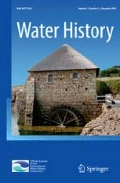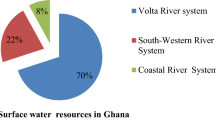Abstract
Water has played a vital role in life in Greece during its long history. Ancient Greek societies were very active in the field of water management, resulting in an impressive variety of hydraulic works. The main purpose of this paper is to discuss the operation of one of the most ancient and extended hydraulic works, the drainage project of Lake Copais in Central Greece. The project was developed and operated by the Minyans, a powerful Mycenaean group. The Minyans partially diverted two large rivers which fed the lake. The water was conveyed towards labyrinthine natural sinkholes, which were formed in limestone terrain. Through the sinkholes, water slowly discharged to the sea. This impressive ancient water management system has gained the attention of many scientists and has been extensively studied by archaeologists and engineers. Still, important questions remain about the way the hydro-system worked. Trying to provide some reliable answers, we have studied the Minyans’ interventions from a hydraulic engineering perspective. Available archeological, hydrological and geological data of the area were used to evaluate the operation of the system. The main elements of the hydro-system are presented and their purposes examined. For this, (i) a water balance model was developed and (ii) the hydro-system was simulated using synthetic time series of the hydrological processes. Several operational cases were examined in order to define critical parameters of the system, such as water level variation and water accumulation in the sinkholes. The analysis reveals some significant factors, which could be related to archaeological findings and the hydro-system’s performance.








Similar content being viewed by others

References
Angelakis AN, Savvakis YM, Charalampakis G (2006) Minoan Aqueducts: A Pioneering Technology. In: Angelakis AN, Koutsoyiannis D (eds) 1st IWA international symposium on water and wastewater technologies in ancient civilizations. Heraklion, Greece, 423–429
Angelakis AN, Mamassis N, Dialynas E, Defteraios P (2014) Urban water supply, wastewater, and stormwater considerations in ancient Hellas: lessons learned. Environ Nat Resour Res 4(3). doi:10.5539/enrr.v4n3p95
Constantinidis D (1984) Report 1: final design of the flood protection works in the Boeoticos Kephisos river basin. Commissioner: Ministry of Public Works, Contractor: D. Constantinidis, Athens
Dearing JA, Battarbee RW, Dikau R, Larocque I, Oldfield F (2006) Human-environment interactions: towards synthesis and simulation. Reg Environ Change 6:115–123
Efstratiadis A, Nalbantis I and Rozos E (2004). Model for simulating the hydrological cycle in Boeoticos Kephisos and Yliki basins. Modernisation of the supervision and management of the water resource system of Athens, report 21, Department of Water Resources, Hydraulic and Maritime Engineering—National Technical University of Athens, Athens
Ertsen MW (2010) Structuring properties of irrigation systems. Understanding relations between humans and hydraulics through modeling. Water Hist 2:165–183
Ertsen MW (2013) A poor workman blames his tools or how irrigation systems structure human actions. In: Casella E, Evans G, Harvey P, Knox H, Mclean C, Silva E, Thoburn N, Woodward K (eds) Objects and materials. A Routledge companion. Routledge, London, pp 40–49
Hohensinner S, Sonnlechner C, Schmid M, Winiwarter V (2013) Two steps back, one step forward: reconstructing the dynamic Danube riverscape under human influence in Vienna. Water Hist 5:2
Janssen MA, Anderies JM (2007) Stylized models to analyze robustness of irrigation systems. In: Kohler TA, Leeuw SE (eds) The model-based archaeology of socionatural systems. School for Advanced Research Press, Santa Fe, pp 157–173
Kambanis M (1893) Le dessèchement du lac Copais par les anciens (The drainage of the Kopais lake by the ancients). Bulletin de Correspondance Hellenique 17:322–342
Knauss J (1995) NE Kopais: technical—historical aspects of the unfinished ancient drainage tunnel. Proc Soc Boeotian Stud 2(1):83–95
Knauss J (2000) The prehistoric water management and land reclamation system in the Kopais Basin, Boiotia, middle Greece. ICID J 49(4):39–48
Kountouri E, Petrochilos N, Liaros N, Oikonomou V, Koutsoyiannis D, Mamassis N, Zarkadoulas N, Vött A, Hadler H, Henning P, Willershäuser T (2013) The Mycenaean drainage works of north Kopais, Greece: a new project incorporating surface surveys, geophysical research and excavation. Water Sci Technol: Water Supply 13(3):710–718
Koutsoyiannis D, Angelakis AN (2007) Agricultural hydraulic works in ancient Greece. In: Trimble SW (ed) Encyclopedia of water science, 2nd edn. CRC Press, Boca Raton, pp 24–27
Koutsoyiannis D, Tarla K (1987) Sediment Yield Estimations in Greece. Technica Chronica A-7(3):127–154
Mariolakos ID (2009) Geological knowledge of Greeks in the era of Trojan war, science and technology in Homeric epics. Hist Mech Mach Sci 6:243–255
Rachet G (1993) Civilisations et archeology de la Grece prehellenique. Edutions du Rocher, Monaco
Schnitter NJ (1994) A history of dams-the useful pyramids. Balkema, Rotterdam
Wilkinson TJ, Gibson M, Widell M (2013) Models of Mesopotamian landscapes: how small-scale processes contributed to the growth of early civilizations. Archaeopress, Oxford
Zarkadoulas N, Koutsoyiannis D, Mamassis N, Papalexiou SM (2008) Climate, water and health in ancient Greece, European Geosciences Union General Assembly, geophysical research abstracts, vol 10, Vienna
Acknowledgments
We would like to thank the editor Dr. M. Ertsen and the two anonymous reviewers for their constructive comments that helped us improve the structure and the presentation of our work. Fruitful discussions with Dr. D. Koutsoyiannis, are also gratefully acknowledged.
Author information
Authors and Affiliations
Corresponding author
Appendix
Appendix
Hydrological model equations
For each monthly time step n the following components of the hydrosystem are defined:
-
Qkifn, the monthly discharge of Boiotikos Kephisos river in hm3
-
Qmeln, the monthly discharge of Melas river in hm3
-
Qepln, the total monthly discharge of Erkynas, Pontzas and Lofis rivers in hm3
-
Qsinkn, the monthly discharge capacity of sinkholes in hm3
-
Virrn, the monthly irrigation needs in hm3
-
Wcopn, the monthly withdrawal from Copais lake in case that irrigation needs are not satisfied in hm3
-
Skopn, the storage of Copais lake at the end of the month n in hm3
-
Ssinkn, the storage of sinks lake at the end of the month n in hm3
-
Acopn, the mean monthly area of Copais lake in km2
-
Pn, The monthly areal precipitation in mm
-
En, the monthly areal lake evaporation in mm
The operational rules of the hydrosystem are the following:
A portion a i of the monthly discharges of Boiotikos Kephisos and Melas discharges flow to Lake Copais and the remaining water is diverted to the sinkhole area. The storage of the lake formulated in front of the sinks at the end of the month is given by the equation
The irrigation needs are satisfied by the remaining monthly discharges of Boiotikos Kephisos and Melas rivers and from the total monthly discharges of Erkynas, Pontzas and Lofis streams. In case that the river discharges are less than irrigation needs a withdrawal from lake Copais is performed.
The withdrawal from Lake Copais is given by the equation
The storage of lake Copais at the end of the month is given by the equation
Simulation procedure
The hydrosystem was simulated for fixed initial conditions and for two different sink capacities that are presented in Table 2.
Rights and permissions
About this article
Cite this article
Mamassis, N., Moustakas, S. & Zarkadoulas, N. The operation of ancient reclamation works at Lake Copais in Greece. Water Hist 7, 271–287 (2015). https://doi.org/10.1007/s12685-015-0126-x
Received:
Accepted:
Published:
Issue Date:
DOI: https://doi.org/10.1007/s12685-015-0126-x



